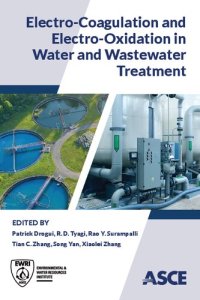
Ebook: Electro-Coagulation and Electro-Oxidation in Water and Wastewater Treatment
- Genre: Technique // Water Treatment
- Year: 2022
- Publisher: American Society of Civil Engineers
- City: Reston
- Language: English
- pdf
Electro-Coagulation and Electro-Oxidation in Water and Wastewater Treatment provides current state-of-the-art fundamentals and applications of electro-coagulation (EC) and electro-oxidation (EO) for water/wastewater treatment. EC and EO are based on the principle of introducing an electrical current to induce chemical reactions in the system, causing the destabilization of most pollutants (e.g., suspended particles, bacteria, viruses, dissolved materials, metals, hydrocarbons, and many organics). The relatively low energy consumption, absence of chemical utilization with the potential recovery, and reuse of treated water, as well as total size flexibility for usage in both urban and rural areas, make EC and EO true green technologies for water/wastewater treatment.
This book presents a detailed overview of the origins, principles, benefits, impacts, and applications of EC and EO processes. Topics include
- General basics, origins, and principles of EC and EO processes;
- Mathematical modeling of EC and EO;
- Combinations of EC with other treatment or emerging technologies such as electrocoagulation-photo-assisted, sono-electrocoagulation, electrocoagulation-fenton, electrocoagulation-electro-oxidation, electrocoagulation-peroxidation, and ozone assisted-electrocoagulation processes;
- Combinations of EO with other treatment or emerging technologies such as sono-electro-oxidation, electro-peroxidation, electro-peroxone, electro-fenton, electro-oxidation filtration, and coupling electro-oxidation and biofiltration processes;
- Environmental applications of EC and EO processes;
- Comparative studies among EC, adsorption, and chemical precipitation;
- Comparative studies among EO and other oxidation processes;
- Cost comparison of EC/EO processes with other clean-up technologies; and
- Challenges and future perspectives of EC and EO processes.